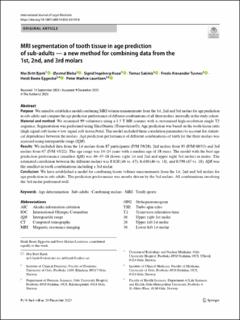| dc.contributor.author | Bjørk, Mai Britt | |
| dc.contributor.author | Bleka, Øyvind | |
| dc.contributor.author | Kvaal, Sigrid Ingeborg | |
| dc.contributor.author | Sakinis, Tomas | |
| dc.contributor.author | Tuvnes, Frode Alexander | |
| dc.contributor.author | Eggesbø, Heidi Beate | |
| dc.contributor.author | Lauritzen, Peter Mæhre | |
| dc.date.accessioned | 2024-02-12T08:38:42Z | |
| dc.date.available | 2024-02-12T08:38:42Z | |
| dc.date.created | 2024-01-15T09:41:53Z | |
| dc.date.issued | 2023 | |
| dc.identifier.citation | International journal of legal medicine (Print). 2023, 1-11. | en_US |
| dc.identifier.issn | 0937-9827 | |
| dc.identifier.uri | https://hdl.handle.net/11250/3116760 | |
| dc.description.abstract | Purpose WeaimedtoestablishamodelcombiningMRIvolumemeasurementsfromthe1st,2ndand3rdmolarsforageprediction in sub-adults and compare the age prediction performance of different combinations of all three molars, internally in the study cohort. Material and method We examined 99 volunteers using a 1.5 T MR scanner with a customized high-resolution single T2 sequence. Segmentation was performed using SliceOmatic (Tomovision©). Age prediction was based on the tooth tissue ratio (high signal soft tissue + low signal soft tissue)/total. The model included three correlation parameters to account for statisti- cal dependence between the molars. Age prediction performance of different combinations of teeth for the three molars was assessed using interquartile range (IQR).
Results We included data from the 1st molars from 87 participants (F/M 59/28), 2nd molars from 93 (F/M 60/33) and 3rd molars from 67 (F/M 45/22). The age range was 14–24 years with a median age of 18 years. The model with the best age prediction performance (smallest IQR) was 46–47-18 (lower right 1st and 2nd and upper right 3rd molar) in males. The estimated correlation between the different molars was 0.620 (46 vs. 47), 0.430 (46 vs. 18), and 0.598 (47 vs. 18). IQR was the smallest in tooth combinations including a 3rd molar.
Conclusion We have established a model for combining tissue volume measurements from the 1st, 2nd and 3rd molars for age prediction in sub-adults. The prediction performance was mostly driven by the 3rd molars. All combinations involving the 3rd molar performed well. | en_US |
| dc.language.iso | eng | en_US |
| dc.rights | Navngivelse 4.0 Internasjonal | * |
| dc.rights.uri | http://creativecommons.org/licenses/by/4.0/deed.no | * |
| dc.title | MRI segmentation of tooth tissue in age prediction of sub-adults — a new method for combining data from the 1st, 2nd, and 3rd molars | en_US |
| dc.type | Peer reviewed | en_US |
| dc.type | Journal article | en_US |
| dc.description.version | publishedVersion | en_US |
| cristin.ispublished | true | |
| cristin.fulltext | original | |
| cristin.qualitycode | 1 | |
| dc.identifier.doi | 10.1007/s00414-023-03149-0 | |
| dc.identifier.cristin | 2226282 | |
| dc.source.journal | International journal of legal medicine (Print) | en_US |
| dc.source.pagenumber | 1-11 | en_US |

